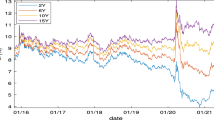Abstract
We derive Bayesian confidence intervals for the probability of default (PD), asset correlation (Rho), and serial dependence (Theta) for low default portfolios (LDPs). The goal is to reduce the probability of underestimating credit risk in LDPs. We adopt a generalized method of moments with continuous updating to estimate prior distributions for PD and Rho from historical default data. The method is based on a Bayesian approach without expert opinions. A Markov chain Monte Carlo technique, namely, the Gibbs sampler, is also applied. The performance of the estimation results for LDPs validated by Monte Carlo simulations. Empirical studies on Standard & Poor’s historical default data are also conducted.










Similar content being viewed by others
References
Andersen LBG, Sidenius J (2004) Extensions to the Gaussian copula: random recovery and random factor loadings. J Cred Risk 1:29–70
Bangia A, Diebold FX, Kronimus A, Schagen C, Schuermann T (2002) Ratings migration and the business cycle, with applications to credit portfolio stress testing. J Banking Financ 26:445–474
Basel Committee on Banking Supervision (2011) A global regulatory framework for more resilient banks and banking systems-revised version. Consultative Document. Bank for International Settlements. http://www.bis.org/publ/bcbs189.pdf
Bluhm C, Overbeck L, Wagner C (2010) Introduction to credit risk modeling. Chapman & Hall/CRC, London
Carlin BP, Louis TA (2008) Bayesian methods for data analysis. Chapman & Hall/CRC, London
Chang YP, Yu CT, Liu H (2011) Bayesian inference for credit risk with serially dependent factor model. Int J Infor Manag Sci 22:135–155
Chen MH, Shao QM (1998) Monte Carlo estimation of Bayesian credible and HPD intervals. J Comput Graph Stat 8:69–92
Chen MH, Shao QM, Ibrahim JG (2000) Monte Carlo methods in Bayesian computation. Springer, New York
Dwyer DW (2007) The distribution of defaults and Bayesian model validation. J Risk Model Valid 1:23–53
Frey R, McNeil A (2003) Dependent defaults in models of portfolio credit risk. J Risk 6:59–92
Ghosh J, Delampady M, Samanta T (2006) An introduction to Bayesian analysis: theory and methods. Springer, New York
Gilks WR, Wild P (1992) Adaptive rejection sampling for Gibbs sampling. Appl Stat 41:337–348
Gilks WR, Best NG, Tan KKC (1995) Adaptive rejection metropolis sampling within Gibbs sampling. Appl Stat 44:455–472 (Correction, Gilks et al. (1997) Appl Stat 46:541–542)
Gordy MB (2003) A risk factor model foundation for ratings based capital rules. J Financ Intermed 12:199–232
Hansen LP (1982) Large sample properties of generalized method moments estimators. Econometrica 50:1029–1054
Hansen LP, Heaton J, Yaron A (1996) Finite sample properties of some alternative GMM estimators. J Bus Econ Stat 14:262–280
Hanson S, Schuermann T (2006) Confidence intervals for probabilities of default. J Banking Financ 30:2281–2301
Jacobs M Jr, Kiefer NM (2010) The Bayesian approach to default risk: a guide. In: Bocker K (ed) Rethinking risk measurement and reporting: Volume II. Risk Books, London, pp 319–344
Jafry Y, Schuermann T (2004) Measurement, estimation and comparison of credit migration matrices. J Banking Financ 28:2603–2639
Kiefer NM (2007) The probability approach to default probabilities. Risk 20:146–150
Kiefer NM (2009) Default estimation for low default portfolio. J Empir Financ 16:164–173
Kiefer NM (2010) Default estimation and expert information. J Bus Econ Stat 28:320–328
Kiefer NM (2011) Default estimation, correlated defaults, and expert information. J Appl Econ 26:173–192
McNeil AJ, Wendin JP (2007) Bayesian inference for generalized linear mixed models of portfolio credit risk. J Empir Financ 14:131–149
Miu P, Ozdemir B (2008) Estimating and validating long-run probability of default with respect to Basel II requirements. J Risk Model Valid 2:3–41
Orth W (2011) Default probability estimation in small samples—with an application to sovereign bonds. Working paper
Pluto K, Tasche D (2005) Thinking positively. Risk 18:72–78
Pluto K, Tasche D (2011) Estimating probabilities of default for low default portfolios. In: Engelmann B, Rauhmeier R (eds) The Basel II risk parameters. Springer, Berlin, pp 75–101
Robert C, Casella G (2004) Monte Carlo statistical models. Springer, New York
Rösch D, Scheule H (2004) Forecasting retail portfolio credit risk. J Risk Financ 5:16–32
Standard & Poor (2012) Default, transition, and recovery: 2011 annual global corporate default study and rating transitions. Technical Report Global Fixed Income Research
Tasche D (2012) Bayesian estimation of probabilities of default for low default portfolios. Working paper
Wilde T, Jackson L (2006) Low-default portfolios without simulation. Risk 19:60–63
Acknowledgments
The authors are grateful to the reviewer’s valuable comments that improved the manuscript.
Author information
Authors and Affiliations
Corresponding author
Appendix
Appendix
In Sect. 3, we use the GMM method with the CU approach to estimate the prior parameters. The GMM method with CU estimators is based on the expectation values (15) and (16). To derive these expectation values, we introduce two lemmas.
Lemma 1
Andersen and Sidenius (2004). For any constants \(a\) and \(b\),
Lemma 2
Let \(y \sim \hbox {Binomial}(n, p)\), then, for \(n \ge k\),
From Lemmas 1 and 2, it can be shown that
Now, the expectation value (15) is
and, for \(k=2, 3, 4\), we obtain (16),
Rights and permissions
About this article
Cite this article
Chang, YP., Yu, CT. Bayesian confidence intervals for probability of default and asset correlation of portfolio credit risk. Comput Stat 29, 331–361 (2014). https://doi.org/10.1007/s00180-013-0453-2
Received:
Accepted:
Published:
Issue Date:
DOI: https://doi.org/10.1007/s00180-013-0453-2




